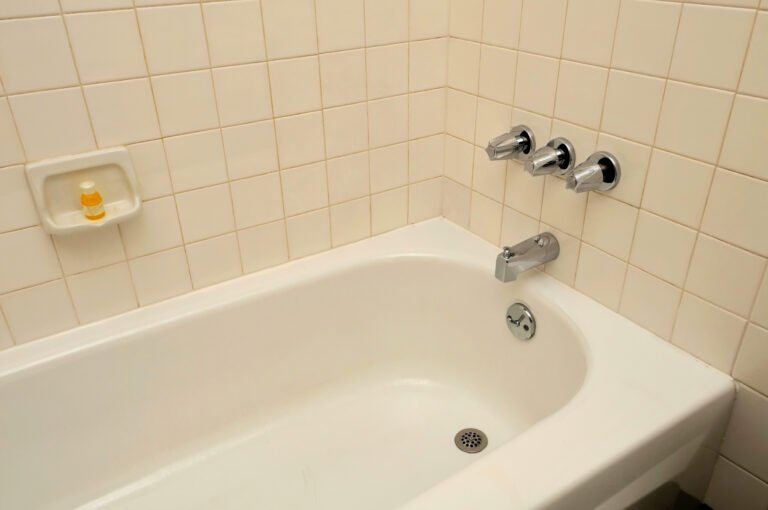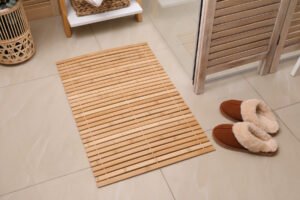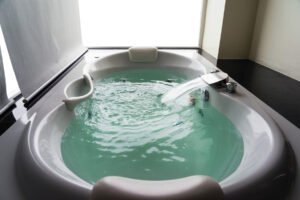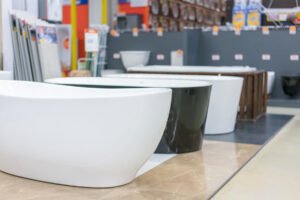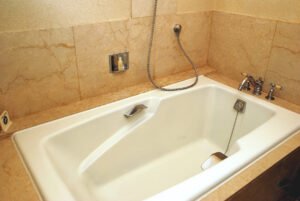Bathtubs are integral to your cleaning routine and extensively impact your health. They need to be spick, span, and free of hazardous sewer gases, failing which can cause serious health issues, like respiratory and severe skin problems! So, how do you block these harmful gases?
One way is to add a trap that sits at the tub’s bottom and prevents gas from re-entering your bathroom. But does a bathtub really need a trap, or can it do well without one? If yes, how do you install a trap? Let’s find out!
Every bathtub needs a trap to prevent harmful sewer gases from entering your plumbing system. The trap also prevents foul smells, bacteria, cockroaches, and other insects from entering inside through the tub drain and disrupting your bathroom hygiene.
What is a Plumbing Trap?
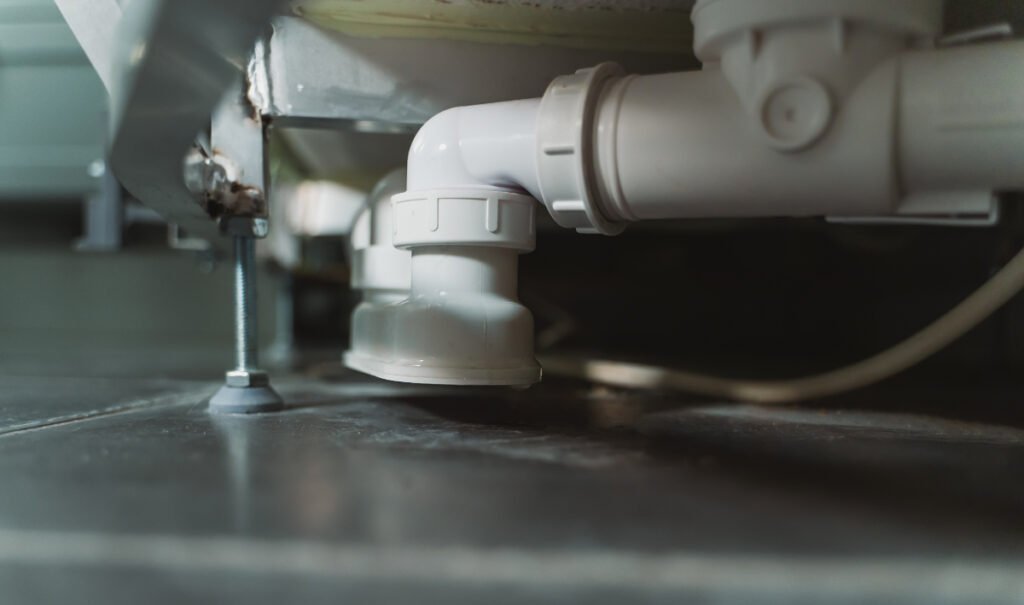
The plumbing trap is a bent, fluid-containing metal, PVC, or plastic pipe below the tub drain that forms a water seal to trap odor, methane, ammonia, and other harmful gases down the plumbing system.
Additionally, it is a self-cleaning plumbing fixture that ensures smooth drainage and efficiently eliminates sewage and wastewater from your piping.
Plumbing Codes for Bathtub Trap Installation
The International Uniform Plumbing Code has a fixed set of rules and regulations that govern the sizes, structures, and materials of some wastewater fixtures, such as the plumbing vent pipe, shower drain, toilet drain, and traps.
Some of these codes are:
- The p trap and the drain line outlet should use similar pipes more than 1.5 inches in diameter.
- The distance between the bottom of the bathtub and the top of the trap should not be more than 24 inches.
- The bathtub trap must be self-cleaning and must have a standard design, weight, structure, and materials.
- Wherever necessary, each bathtub trap should have a standing water seal of 51mm—102 mm and be protected from freezing.
- Every bathtub trap shall have a connecting vent or air vent on the inlet side of the trap, and its pipe size should be half the diameter of the drain.
- The trap shall work without mechanical help or motor and pass water freely without obstruction.
- The trap shall have a smooth surface from the inside, and there should be no internal projections that trap hair, lint, or other substances in the trap weir.
Advantages of Installing Bathtub Traps
- Sanitation & Hygiene: A trap allows wastewater to discharge into the main drain smoothly and prevents any dirt or foul smells from re-entering your bathroom.
- Traps Sewer Gases: They seal and prevent harmful sewer gases like Methane, Carbon monoxide, Nitrogen, and Hydrogen sulfide, which may cause headaches, suffocation, and nausea in humans, to leak in the plumbing system.
- Catch Solids: Traps catch and break down solids like hair and lint that might clog the drain pipe. Moreover, they collect all the sediment in easy-to-access places, and you can remove it quickly to avoid a clog.
- Eliminates Pests: Traps contain a water seal that prevents rats, cockroaches, worms, and mice from entering your bathroom via the drain system.
| Bathtubs With Traps | Bathtubs Without Traps |
| Require proper maintenance, regular drain cleaning, and an additional installation cost of $50-60. | Not at all expensive to install, but it might be tricky to clean and unclog. |
| Sewer gases are trapped within the system and cannot re-enter the bathroom. | Harmful exhaust and sewer gases might return to the bathroom, disrupting health and hygiene. |
| It prevents foul smells and ensures a clean bathtub. | It doesn’t eliminate foul odors and waste residues from the system. These will not only lead to a smelly bathtub but will also add a light, yellowish stain on its surface. |
| It prevents vermin from entering your plumbing system. | Allows vermins and rodents to enter, exit, and breed in your plumbing. |
| Traps solid residue at the top and does not clog easily. | Lets residue freely pass through the plumbing and may clog easily. |
Do All Bathtubs Need Plumbing Traps?
Yes, all bathtubs need plumbing traps to drain wastewater and harmful gases from their system and ensure a clean, odor-free bathtub. For plastic and acrylic bathtubs, use ABS (Acrylonitrile butadiene styrene) traps, and for metal and fiberglass tubs, use standard PVC traps.
Furthermore, choose galvanized traps for older constructions with cast iron or galvanized iron pipes, but be sure to join it with a dielectric fitting to keep it rust and corrosion-free.
Dielectric fitting is a process that creates a barrier between two metal pipes to restrict the unintentional production of electricity that causes pipes to rust.
What Are the Standard Types of Bathtub Traps?
- P Trap: A p trap is a curved pipe that creates a water seal under the tubs and efficiently traps solid residues, gases, and foul smells. These popular traps fit well in-wall connections and use compression fittings to create a water seal that traps sewer gases together.
- Q Trap: Q traps are deep, elongated, but compact. Hence, they fit nicely under the bathtubs of top apartment floors and residential buildings with sunken slabs.
- S Trap: If your bathtub is far away from the bathroom walls, you can use an s trap to connect it to the main sewer line through an outlet from the floor.
- Drum Trap: A drum trap is a large, cylindrical trap with a large water seal that traps harmful sewer gases and lets them out through an outlet in the piping. However, the drum trap is so huge that the solid waste settles down at the bottom of the trap instead of flushing out and may lead to a clogged drain frequently.
How Do You Install a Bathtub Drain Trap Efficiently?
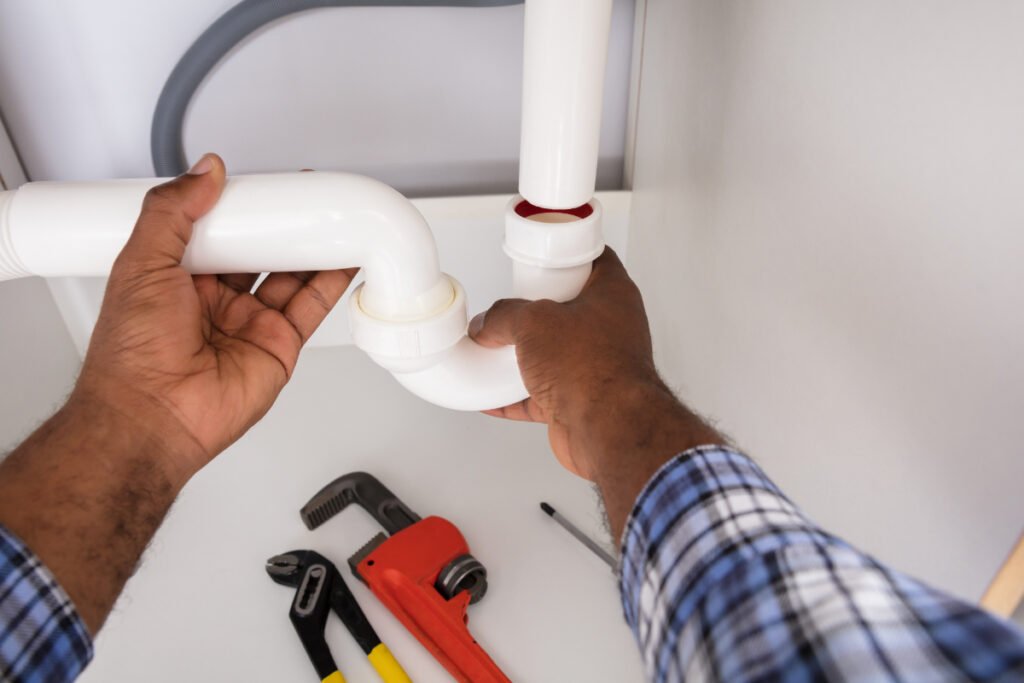
A bathtub trap sits under the drain opening and connects to the main bathroom sink drain via a horizontal pipe. Thus, it’s crucial to locate the bathtub drain and ensure it’s free from any hair clogs, lint, or solid waste that might disrupt the trap installation.
So, once you have cleaned it, follow the steps to install a trap efficiently.
Equipment you’ll need:
- Plumbing Tape
- Adjustable pliers
- PVC bathtub p trap
- Sanitary tee
- PVC Cement
Tools you’ll need:
- PVC Adapter
- 1 ½ inch PVC pipe
- Hacksaw
- File
- Tape measure
- 1-foot level
- Felt marker
Step-by-Step Instructions to Install a Bathtub Trap:
- Step 1: Screw a 1 ½ inch PVC adapter at the bathtub drain outlet and tighten it with adjustable pliers. Now, cut a 4-inch groove on the PVC pipe, sand it a little with a file, and fit it inside.
- Step 2: Use plumbing tape to measure the distance between the bathtub drain and the waste stack. Then, cut a PVC pipe horizontally and fit it.
- Step 3: Use a 1-foot level and place the trap at ¼ inch slope where the pipe meets the waste water stack.
- Step 4: Drill a hole in the waste water stack and install a sanitary tee using a threaded fitting and heavy-duty screw.
- Step 5: Attach the horizontal PVC pipe to the tee and mark their positions correctly with a felt marker. Finally, glue all the pipes together, and you are done!
Don’t use a sink drain trap or shower p trap for the bathtub, as it may damage the tub framing and drains.
Common Problems with a Bathtub Trap
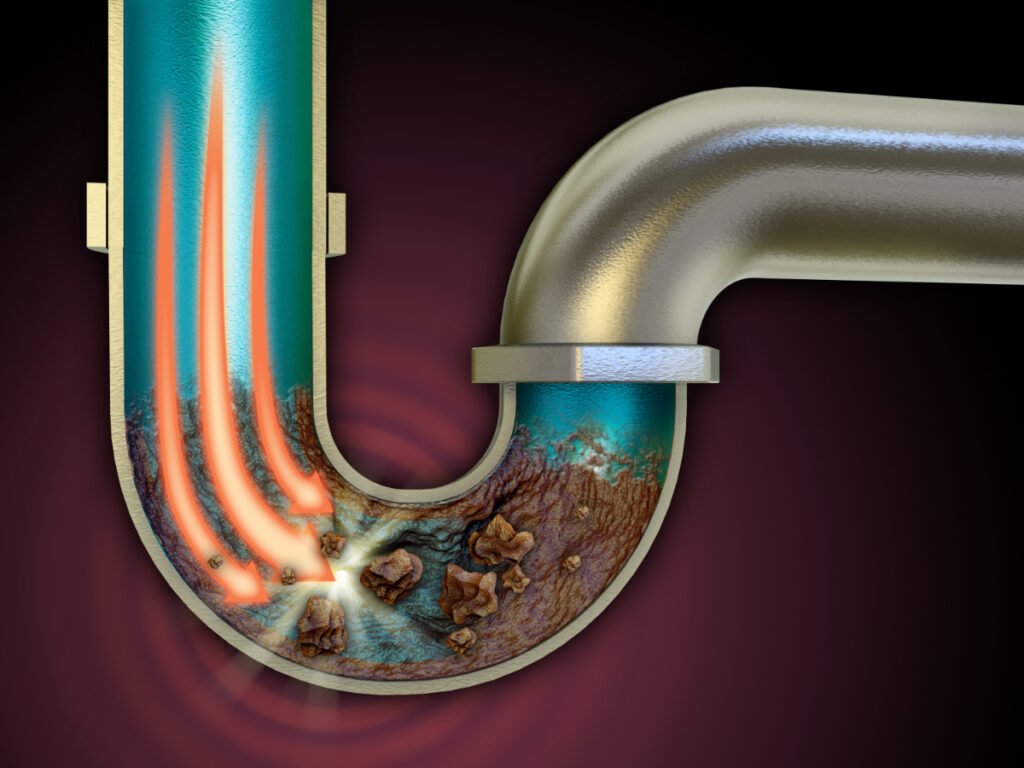
Improper installation, maintenance, and water pressure may cause a trap to wear out faster and disrupt its optimal functioning. Plus, many problems with the water seals, materials, and clogs need immediate attention from a plumber. Let us identify some of them.
1. Siphonage: Excess air from the vent pipe may drain out the trap’s water seal, leaving it dry and incapable of trapping gases. In such a case, call a professional plumber and refill the trap immediately.
2. Water Overflow: Negative pressure from the overflow drain may cause the wastewater to move upwards, beyond the trap, and out of your bathtub. Check for any clogs in the trap or run a plumbing snake down the pipe in such a situation.
3. Clogs: Larger solid waste, plastic bags, sanitary debris, and toys can easily slide through a damaged drain cover and clog a trap if not removed quickly. Clogged traps lead to a foul smell and do not break down solid waste such as soap scum and dirt.
4. Fluctuations in the Water Seal: Sometimes, extreme temperatures, winds, or snow cause negative pressure in the piping and an increase or decrease in the water seal, thus releasing some of the trapped sewer gases back into the system.
Hence, always use a good quality PVC pipe for the traps instead of metal or cast-iron ones that expand and contract with temperature changes.
5. Evaporation: The trap’s water seal evaporates if you do not use the bathtub frequently. Hence, always cover the bathtub drain with a breathable fabric or wash it regularly if you do not plan to use it weekly.
How to Clean a Clogged Bathtub Trap?
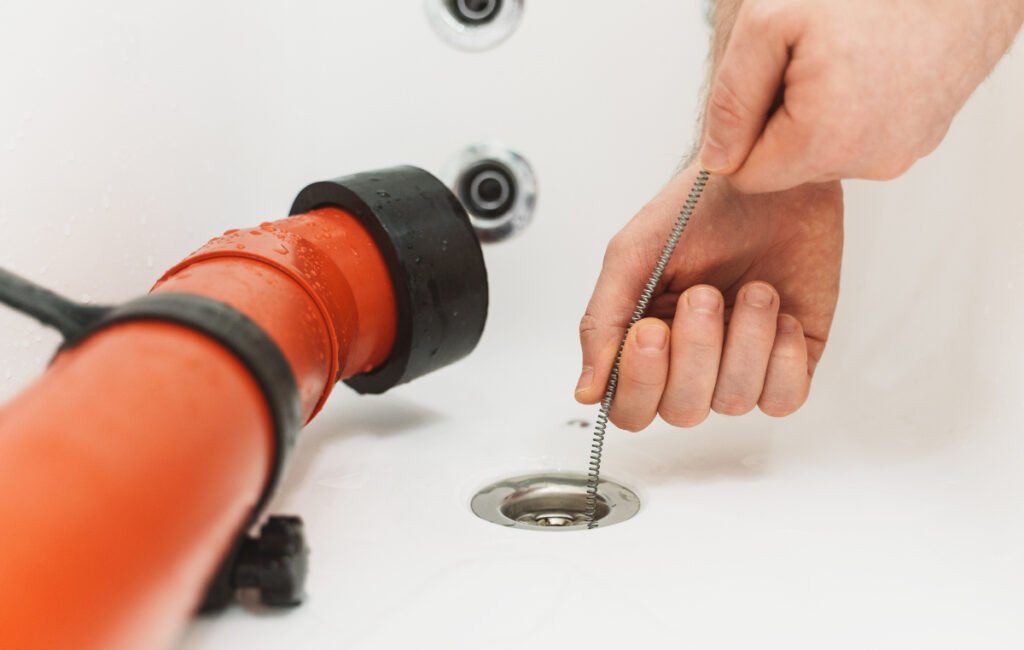
Fixing a clogged bathtub trap is quite easy. Start by marking the trap’s location and open its access panel on the wall opposite the bathtub. Run a plumber’s snake through it and note down the location of the clog.
After that, just follow the steps below to quickly unclog your bath trap:
- Use the Trap Cleanout Plug: Most bathtub traps have a self-cleanout plug that forces the water seal downwards and effectively removes all the trapped solid waste. However, you’ll need to empty the bathtub before using the plug, as it may put additional pressure on the tub drain.
- Run a Plumber’s Snake: Run a small, 25-inch snake through the trap, apply pressure, twist it, and force out all the solid waste from the pipe.
- Use a Bathtub Drain De-clogger: Pour some declogging powder in the trap, let it sit for about 10-15 minutes, and run water for about five minutes to unclog the drain.
Warning: Do not run a plumber’s snake without removing the pop-up assembly, as it may damage the bathtub drain altogether.
How to Keep Pests Away from the Trap?
You can add a thin layer of concrete or gravel to your trap to keep cockroaches, mice, and other vermin at bay. You can even treat the trap with an insecticide or termiticide foam spray to kill termite eggs from the piping. Or you can install a mesh barrier to seal bathtub traps.
Does a shower drain need a P trap?
Yes, a shower drain needs a p trap to keep sewer gases, solid waste accumulations, and water clogs at bay. However, you can even use s or q traps if your shower is far away from the wall and needs an outlet via the floor.
Why does my P trap smell bad?
P traps smell bad when their water seal dries completely, and there is no barrier left to seal foul smells and gases in the plumbing system. In such a situation, call a professional plumber to restore your trap’s water seal and drain the bathtub regularly to maintain it.
How far can a P trap be from the bathtub?
P traps should not be more than 30-inches away from the sides of the bathtub and should connect to the central vent via the wall. But, if your bathtubs are far from the wall, you can use an s or q trap or install faux drywall near the tub to hold the p trap.
How much does a P trap cost?
P traps are highly affordable and will cost about $60-75 per dozen, depending on the trap size. Moreover, replacing the trap will cost about $200-325 if it fails or doesn’t hold the water seal.
Traps are crucial for high-use plumbing fixtures such as bathtubs. They ensure proper drainage, prevent sewer gases, and keep your bathtub as clean as new!
But traps alone are not enough for plumbing fixtures to hold solid waste. They may need an additional vent for easy cleaning. The kitchen sink is one fixture that clogs easily due to the bits and pieces of solid waste. But does a kitchen sink need a vent? Hop on to our guide to learn more.

